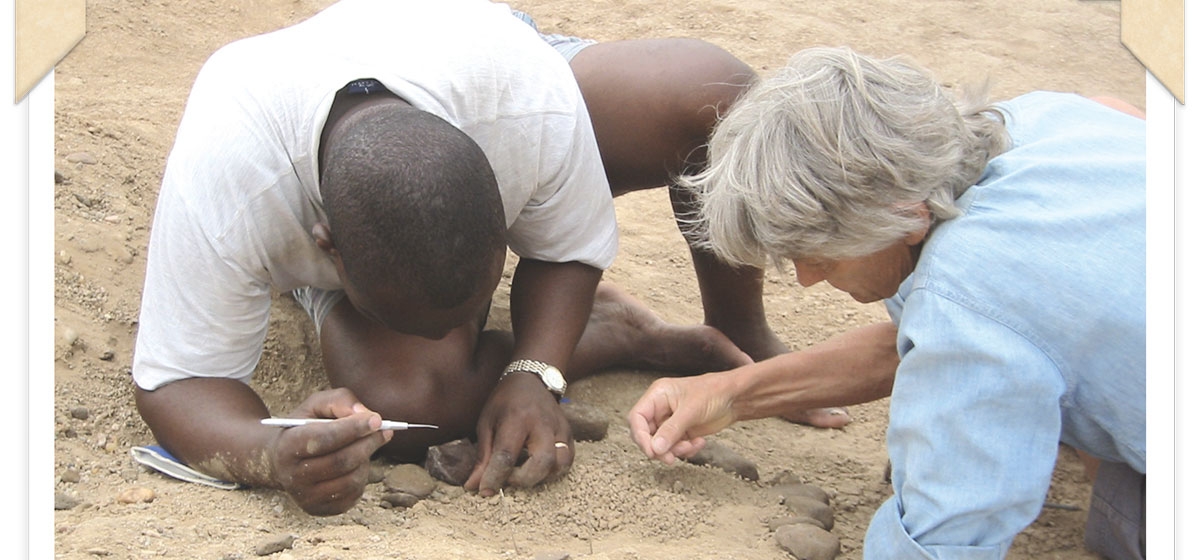
It’s tough to make a non-fiction work on paleoanthropology entertaining. The search for early forms of fossil man is commonly perceived as a dry one, figuratively and literally; comprising years upon years of tiresome labor by pedantic academics in wretched climates and occasionally yielding a fractured femur with which the average dog couldn’t be bothered.
As pleasure reading, it is not the stuff of bestsellers, which is what makes the success of “The First Human: The Race to Discover our Earliest Ancestors” such an accomplishment. Targeted at a lay audience more likely to associate Java Man with a barista at Starbucks than with his fossilized forebear Homo erectus, the book is fast-paced, engaging, informative, surprising and yes, entertaining.
What HGTV has done for home repairs, local science writer Ann Gibbons has done for her field; namely, condensed the practical tedium to get right to the good stuff: the new, improved evidence for human evolution and the colorful characters who give the story life.
A fragmented skull discovered in Chad in 2002 currently holds the title of Our Earliest Known Ancestor. Named Sahelanthropus tchadensis and informally dubbed Toumaï (meaning “hope of life” in the language of the desert where it was found), it possesses characteristics of both humans and chimpanzees. It is, as one observer noted, “a bit like the Grail for a researcher,” representing as it does the closest specimen yet to the evolutionary split between humans and apes.
This ancient hominid is separated from modern man by an estimated six to seven million years, but its discovery came only 131 years after the publication of The Descent of Man, in which Charles Darwin posited Africa as the cradle of humanity, and less than 50 years after Mary and Louis Leakey provided fossil evidence supporting that theory. For 15 of those years, Gibbons has been covering evolution for Science magazine. In that time, advances have been significant and rapid, with one momentous discovery following another. But theses advances have been tempered by divisions seldom noted in the literature of the field. Personality conflicts and professional rivalries frequently affect access to specimens and fossil sites and even determine the hypotheses that define paleoanthropology today. Gibbons, writing as a reporter rather than a researcher, emphasizes science as a “social endeavor,” and combines “the human story of the quest” with its scientific results.
Darwin’s theories still form the foundation of paleoanthropologic research, but beyond the premise of evolution, there is a remarkable lack of consensus within the discipline. Did human life begin in the geologically anomalous Great Rift Valley or on the shores of prehistoric Lake Chad? Did humans evolve in a linear “tree of life” fashion or a more disparate “bush” fashion? Should similar fossils be “lumped” together as variations within a species or “split” into separate species? Is molecular data superior to fossil data as a reference for classification? Did early man adopt an upright stance to handle tools or to ford rivers? Until quite recently, there was not even a standard definition for a human being.
Issues such as these resist resolution because scientists, not surprisingly, support their own findings. Since their quest relies on securing funding and funding depends upon results in the field, it is in the interest of researchers to demonstrate the superiority of their methods and findings and often to discredit their rivals. As a result, competition is fierce. In the chapter titled “Bones of Contention,” Gibbons describes a scene almost comical to readers, in which three world-famous paleoanthropologists argue heatedly about the reconstruction of a shattered jaw, or as she puts it, “fight tooth and nail over a wisdom tooth.”
Leaders in the field are by and large extreme individualists; ambitious, determined and indisposed to compromise. To underscore the role of personality, Gibbons focuses on a handful of distinguished individuals whose characters are as compelling as their discoveries. Among them is Michel Brunet, leader of the French team that unearthed Toumaï. Self-described as a “poor, crazy Socialist,” Brunet struggled in the field for 25 years, undaunted by warfare in Iraq, Afghanistan and Chad. But since Toumaï ‘s discovery, success has been heavy on his shoulders. Exhausted from travel and lectures and haunted by the death of a colleague whom he persuaded to join him in hazardous conditions, he longs only to be alone with the fossils he loves.
Working to the east of Brunet in the Middle Awash of Ethiopia is the intense American Tim White, whose work is so shrouded in secrecy it is known as the “Manhattan Project of Paleoanthropology.” A stickler for perfection, White imposes his “Tim Commandments” of professional ethics on his peers, frequently severing contact with those who fall short.
White’s arrogance engenders the resentment of many, including the iconoclastic team of Brigitte Senut and Martin Pickford, who charge ahead with their own brand of unorthodox research despite concerted efforts to constrain them. Senut, from France, and the British Pickford, who was raised in Kenya, ignore or insult all who stand in their way.
Quietly outside the fray but definitely not out of the picture is the serene and diligent presence of patrician Maeve Leakey. Paleoanthropology royalty owing to her status as daughter-in-law of pioneer Louis Leakey, Welsh-born Maeve achieved independent prominence in the ’90s by unearthing remarkable hominid fossils in the Kenyan valleys associated with her clan.
Punctuating the stories of serious scientific accomplishment are the subplots of personal politics that provide The First Human with its real popular appeal. At times, the book reads almost like a Da Vinci Code for secular humanists; featuring academics obsessed not with the descendants of the holy Sang Real, but with the literal Descent of Man.
Scientists scheme and dissemble as they vie for distinction, and intimations of fraud and theft are used to dispatch competitors. In one instance, described in “Banishment,” accusations of espionage result in the convenient expulsion of an American geologist from politically volatile Ethiopia. The chapter “Turf Wars” is astonishing in its litany of arrests, lawsuits, libelous publications and the formation of unholy alliances by disgruntled outsiders. Irate rivals stage armed confrontations. Sabotage is rumored in the plane crash that crippled the powerful and influential Richard Leakey. Evolutionists level accusations of creationism at one another in the French Academy of Science in a scene that recalls theologians screaming “heresy!” at the Nicene Council. For anyone who ever labored under the misapprehension that scientists are dispassionate automatons, this book sets the record straight.
The author admits that she was urged by some researchers to avoid mention of the more sensational aspects of her story, for fear that it would “reflect poorly on the field and provide ammunition for creationists trying to malign Darwinian evolution and the scientists who have dedicated their careers to understanding it.”They need hardly have worried.
The researchers themselves prove as much about humanity by their own actions as by their research. Gibbons’ balanced presentation of both the data and the drama surrounding it amply demonstrates her thesis that “science lurches forward despite the foibles of individual scientists,” just as mankind advances in spite of human nature.
Was there ever stronger evidence for evolution than that?





